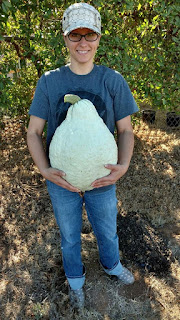What would happen if there were no more fancy colored lettuce in plastic bags and boxes on store shelves? What would you do if they were there but you could no longer afford them?
According to the USDA, food insecurity decline in 2015 by 1.3% from 2014. That sounds great but when you look at the staggering about of people around you that struggle every day to feed themselves and their family it isn't very comforting.
Reasons for Food Insecurities include
Job Loss
Sickness
Rising food costs
Crop failure due to Weather or Water Shortage
Farm labor shortage
Interruptions in transportation of food
Civil unrest
To keep it simple, this article refers to 2 types of food security. The first is the supply chain of food and the second is consumer access based on affordability.
As a homesteader, we grow quite a bit of our own food but we understand that not everyone shares our passion for self-sufficiency. Even though we grow, there are still plenty of food items that are sourced locally or thru grocery stores. Those items don't just magically appear in the store. Someone has to grow them, care for them, harvest them and then transport. One "blip" in the supply chain can be devastating.
 |
| From a single seed we grew this 16+ pound Hubbard Blue Squash |
Food Shortages
We've seen the evidence of food shortages in recent years. Venezuela is an example. Some argue the food is there but the government has control. Some argue that the food is there but it's too expensive and others that there is a true food shortage. Whichever theory you choose to follow, the fact is that the people of Venezuela are in trouble.
Food Waste
In some instances, it's not the lack of food that can be the issue but rather wasting food. Every day perfectly good produces is thrown out because it isn't "pretty" enough to sell.
Corporate takeover of Seed supplies
From our article Protecting Seed Diversity
"Today, three corporations control 53 percent of the global commercial seed market.
Read that sentence again and let that sink in...3 corporations OWN over half of the global commercial seed market!"
Those statistics are WORSE now with the mergers of Syngenta & ChemChina as well as Bayer and Monsanto
 |
| Plant Heirloom Seeds to fight corporate greed! |
In 2006, USDA introduced new language to describe ranges of severity of food insecurity. Let's start with the clear definitions from the USDA
Food Security
High food security (old label=Food security): no reported indications of food-access problems or limitations.
Marginal food security (old label=Food security): one or two reported indications—typically of anxiety over food sufficiency or shortage of food in the house. Little or no indication of changes in diets or food intake.
Food Insecurity
Low food security (old label=Food insecurity without hunger): reports of reduced quality, variety, or desirability of diet. Little or no indication of reduced food intake.
Very low food security (old label=Food insecurity with hunger): Reports of multiple indications of disrupted eating patterns and reduced food intake.
Why do we need these definitions? Well, to better understand their statistics!
Statistics show
Food secure—These households had access, at all times, to enough food for an active, healthy life for all household members.
87.3 percent (109.3 million) of U.S. households were food secure throughout 2015.
An increase from 86.0 percent in 2014.
Food insecure—At times during the year, these households were uncertain of having, or unable to acquire, enough food to meet the needs of all their members because they had insufficient money or other resources for food. Food-insecure households include those with low food security and very low food security.
12.7 percent (15.8 million) of U.S. households were food insecure at some time during 2015.
Down from 14.0 percent in 2014.
Very low food security—In these food-insecure households, normal eating patterns of one or more household members were disrupted and food intake was reduced at times during the year because they had insufficient money or other resources for food.
5.0 percent (6.3 million) of U.S. households had very low food security at some time during 2015.
Down from 5.6 percent in 2014.
From our article Food Prices Continue to Rise
Over the past two decades, food prices have risen 2.6 percent a year on average. But recent factors have slowed food price inflation. The change is only temporary, though. Once those downward pressures abate, food prices will resume their normal upward trend.Let's do the math. In the last 20 years, food prices have increased by 52%
Food Shortages from the Farm
June 2017
"UK summer fruit and salad growers are having difficulty recruiting pickers, with more than half saying they don't know if they will have enough migrant workers to harvest their crops." source
August 2017
"Volatile prices can be blamed on a dismal California harvest, which started in February."
"She said trees were stressed after five years of drought. Extreme heat in July 2016 also hurt this year’s crop. Global supplies also are down." sourceApril 2017
"Lettuce Shortage sends prices soaring" source
April 2011
"Eggplant shortage disrupts supplies to local eateries, groceries" source
MOST of your store-bought food is Imported!
"It is estimated that the average American meal travels about 1500 miles to get from farm to plate." source
"Today, the typical American prepared meal contains, on average, ingredients from at least five countries outside the United States." source
We are fortunate in the US to have access to grocery stores and sophisticated transportation methods. I've given you a good idea with the sources above of the different forms of food insecurities we face. I've also shown that even with our current technology and infrastructure, food insecurities do exist.
What can we do?
As a homesteader, I can tell you what we are doing. Plant a garden and GROW. Every season we expand our gardens to be able to produce more fruits, veggies and herbs. What we do not eat, we preserve for future use or share our abundance.
 |
| Garden goodies I dropped off for my Mom |
We barter fresh produce with one neighbor in exchange for her horse poop. We use the aged horse poop in the garden to produce healthy, abundant crops.
Backyard chickens are a newer adventure for us and so far we're thrilled. It took 5 months growing these tiny chicks into hens but they are now rewarding us with eggs every day.
 |
| Organic eggs from our Hens |
Stock your pantry. For items that you are unable to grow, but in bulk and store for later. We do this as well and it has saved quite a bit of money in the process. Just be sure to rotate your "back-ups."
I hope you have enjoyed another educational article. if you have additional questions, please leave a comment below or send an email to mary@marysheirloomseeds.com
Sign up for our E-Newsletter

